Longitudinal Mechano-Sorptive Creep Behavior of Chinese Fir in Tension during Moisture Adsorption Processes
Abstract
:1. Introduction
2. Materials and Method
2.1. Materials
2.2. Experimental Procedure
2.2.1. Free Swelling Tests at RHI Conditions
2.2.2. VEC and MSC Tests at RHI Conditions
3. Results and Discussion
3.1. Moisture Adsorption Behavior
3.2. Free Swelling
3.3. VEC at Constant MC and MSC during the Adsorption Process
3.4. Application of the Rheological Model under the Assumption of Partitioned Strain
4. Conclusions
- (1)
- Both the VEC and MSC increased with the magnitude of applied stress, and the increasing RH level. Under all RHI conditions, the strain of MSC during the adsorption process was greater than that of VEC at constant MC. The variation of VEC at four RH levels is attributed to the water plasticization effect, whereas the discrepancy of MSC can be seen as a result of the water plasticization effect and the unstable state in the wood cell wall. The unstable state is attributed to the formation of free volumes in the cell walls, and rearrangement of hydrogen bonds. In this study, the RH level promoted the relaxation behavior in MSC, while it slightly affected the relaxation behavior in VEC.
- (2)
- The rheological model used to calculate the MS strain cannot be applied to the tensile creep behavior in this study. The decreased MFA under tensile stress caused the swelling under load to be lower than that in the absence of load, resulting in a smaller MS strain. More importantly, the great difficulty of the rheological model was to isolate the various effects by avoiding inopportune couplings among the anatomic structure of wood, climate conditions, and the load model.
- (3)
- The present work added to the knowledge of creep behaviors in wood, and provided first-hand data regarding the application of the rheological model under the assumption of partitioned strain for tensile creep behaviors. These results can function, in practice, as a basis for safe structural designs of engineering structures of Chinese fir. Given the anisotropy of wood, the arrangement of the constituents had a profound influence on the wood properties in its anatomical directions. The effect of anatomical directions on the application of the rheological model under the assumption of partitioned strain must be investigated with various load models in the future.
Acknowledgments
Author Contributions
Conflicts of Interest
References
- Foraboschi, P. Structural layout that takes full advantage of the capabilities and opportunities afforded by two-way rc floors, coupled with the selection of the best technique, to avoid serviceability failures. Eng. Fail. Anal. 2016, 70, 387–418. [Google Scholar] [CrossRef]
- Foraboschi, P.; Vanin, A. Mechanical behavior of the timber–terrazzo composite floor. Constr. Build. Mater. 2015, 80, 295–314. [Google Scholar] [CrossRef]
- Foraboschi, P. Specific structural mechanics that underpinned the construction of Venice and dictated Venetian architecture. Eng. Fail. Anal. 2017, 78, 169–195. [Google Scholar] [CrossRef]
- Navi, P.; Stanzl-Tschegg, S. Micromechanics of creep and relaxation of wood. A review COST Action E35 2004–2008: Wood machining–micromechanics and fracture. Holzforschung 2009, 63, 186–195. [Google Scholar] [CrossRef]
- Morreale, M.; Liga, A.; Mistretta, M.; Ascione, L.; Mantia, F. Mechanical, thermomechanical and reprocessing behavior of green composites from biodegradable polymer and wood flour. Materials 2015, 8, 7536–7548. [Google Scholar] [CrossRef]
- Skaar, C. Wood-Water Relations; Springer: New York, NY, USA, 1988. [Google Scholar]
- Zhong, Y.; Ren, H.Q.; Jiang, Z.H. Experimental and statistical evaluation of the size effect on the bending strength of dimension lumber of northeast china larch. Materials 2016, 9, 89. [Google Scholar] [CrossRef]
- Engelund, E.T.; Thygesen, L.G.; Svensson, S.; Hill, C.A.S. A critical discussion of the physics of wood–water interactions. Wood Sci. Technol. 2013, 47, 141–161. [Google Scholar] [CrossRef] [Green Version]
- Hill, C.A.S.; Keating, B.A.; Jalaludin, Z.; Mahrdt, E. A rheological description of the water vapour sorption kinetics behaviour of wood invoking a model using a canonical assembly of kelvin-voigt elements and a possible link with sorption hysteresis. Holzforschung 2012, 66, 35–47. [Google Scholar] [CrossRef]
- Hering, S.; Niemz, P. Moisture-dependent, viscoelastic creep of European beech wood in longitudinal direction. Eur. J. Wood Wood Prod. 2012, 70, 667–670. [Google Scholar] [CrossRef]
- Huang, Y. Creep behavior of wood under cyclic moisture changes: Interaction between load effect and moisture effect. J. Wood Sci. 2016, 62, 392–399. [Google Scholar] [CrossRef]
- Yang, T.-C.; Chien, Y.-C.; Wu, T.-L.; Hung, K.-C.; Wu, J.-H. Effects of heat-treated wood particles on the physico-mechanical properties and extended creep behavior of wood/recycled-hdpe composites using the time–temperature superposition principle. Materials 2017, 10, 365. [Google Scholar] [CrossRef] [PubMed]
- Engelund, E.T.; Salmén, L. Tensile creep and recovery of Norway spruce influenced by temperature and moisture. Holzforschung 2012, 66, 959–965. [Google Scholar] [CrossRef]
- Kaboorani, A.; Blanchet, P.; Laghdir, A. A rapid method to assess viscoelastic and mechanosorptive creep in wood. Wood Fiber Sci. 2013, 45, 370–382. [Google Scholar]
- Armstrong, L.; Kingston, R. Effect of moisture changes on creep in wood. Nature 1960, 185, 862–863. [Google Scholar] [CrossRef]
- Armstrong, L.; Christensen, G. Influence of moisture changes on deformation of wood under stress. Nature 1961, 191, 869–870. [Google Scholar] [CrossRef]
- Hunt, D.; Gril, J. Evidence of a physical ageing phenomenon in wood. J. Mater. Sci. Lett. 1996, 15, 80–82. [Google Scholar] [CrossRef]
- Takahashi, C.; Nakazawa, N.; Ishibashi, K.; Iida, I.; Furuta, Y.; Ishimaru, Y. Influence of variation in modulus of elasticity on creep of wood during changing process of moisture. Holzforschung 2006, 60, 445–449. [Google Scholar] [CrossRef]
- Zhan, T.; Jiang, J.; Peng, H.; Lu, J. Dynamic viscoelastic properties of Chinese fir (cunninghamia lanceolata) during moisture desorption processes. Holzforschung 2016, 70, 547–555. [Google Scholar] [CrossRef]
- Zhan, T.; Lu, J.; Jiang, J.; Peng, H.; Li, A.; Chang, J. Viscoelastic properties of the chinese fir (cunninghamia lanceolata) during moisture sorption processes determined by harmonic tests. Materials 2016, 9, 1020. [Google Scholar] [CrossRef] [PubMed]
- Larsen, F.; Ormarsson, S. Experimental and finite element study of the effect of temperature and moisture on the tangential tensile strength and fracture behavior in timber logs. Holzforschung 2014, 68, 133–140. [Google Scholar] [CrossRef] [Green Version]
- Moutee, M.; Fortin, Y.; Laghdir, A.; Fafard, M. Cantilever experimental setup for rheological parameter identification in relation to wood drying. Wood Sci. Technol. 2010, 44, 31–49. [Google Scholar] [CrossRef]
- Muszynski, L.; Lagana, R.; Shaler, S.M. Hygro-mechanical behavior of red spruce in tension parallel to the grain. Wood Fiber Sci. 2007, 38, 155–165. [Google Scholar]
- Muszyński, L.; Lagana, R.; Shaler, S.M.; Davids, W. Comments on the experimental methodology for determination of the hygro-mechanical properties of wood. Holzforschung 2005, 59, 232–239. [Google Scholar] [CrossRef]
- Saifouni, O.; Destrebecq, J.-F.; Froidevaux, J.; Navi, P. Experimental study of the mechanosorptive behaviour of softwood in relaxation. Wood Sci. Technol. 2016, 50, 789–805. [Google Scholar] [CrossRef]
- Hassani, M.M.; Wittel, F.K.; Hering, S.; Herrmann, H.J. Rheological model for wood. Comput. Methods Appl. Mech. Eng. 2015, 283, 1032–1060. [Google Scholar] [CrossRef]
- Moutee, M.; Fortin, Y.; Fafard, M. A global rheological model of wood cantilever as applied to wood drying. Wood Sci. Technol. 2007, 41, 209. [Google Scholar] [CrossRef]
- Vici, P.D.; Mazzanti, P.; Uzielli, L. Mechanical response of wooden boards subjected to humidity step variations: Climatic chamber measurements and fitted mathematical models. J. Cult. Herit. 2006, 7, 37–48. [Google Scholar] [CrossRef]
- Guo, N. Hygro-Mechanical Response of Clear Softwood Specimens to Compression under Cyclic Climate. Master’s Thesis, Oregon State University, Corvallis, OR, USA, 2009. Available online: https://ir.library.oregonstate.edu/xmlui/bitstream/handle/1957/13072/Ning%20Guo'%20s%20MS%20thesis.pdf?sequence=1 (accessed on 8 August 2017).
- Cao, J.; Zhao, G. Dielectric relaxation based on adsorbed water in wood cell wall under non-equilibrium state 2. Holzforschung 2001, 55, 87–92. [Google Scholar]
- Glass, S.V.; Boardman, C.R.; Zelinka, S.L. Short hold times in dynamic vapor sorption measurements mischaracterize the equilibrium moisture content of wood. Wood Sci. Technol. 2017, 51, 243–260. [Google Scholar] [CrossRef]
- Willems, W. Equilibrium thermodynamics of wood moisture revisited: Presentation of a simplified theory. Holzforschung 2016, 70, 963–970. [Google Scholar] [CrossRef]
- Hill, C.A.S.; Norton, A.; Newman, G. Analysis of the water vapour sorption behaviour of sitka spruce [picea sitchensis (bongard) carr.] based on the parallel exponential kinetics model. Holzforschung 2010, 64, 469–473. [Google Scholar] [CrossRef]
- Avramidis, S.; Vancouver, B.C.; Siau, J.; Keene, N.Y. An investigation of the external and internal resistance to moisture diffusion in wood. Wood Sci. Technol. 1987, 21, 249–256. [Google Scholar]
- Yeo, H.; Eom, C.-D.; Han, Y.; Kang, W.; Smith, W.B. Determination of internal moisture transport and surface emission coefficients for eastern white pine. Wood Fiber Sci. 2008, 40, 553–561. [Google Scholar]
- Salmén, L.; Burgert, I. Cell wall features with regard to mechanical performance. A review cost action e35 2004–2008: Wood machining–micromechanics and fracture. Holzforschung 2009, 63, 121–129. [Google Scholar] [CrossRef]
- Salmén, L.; Stevanic, J.S.; Olsson, A.-M. Contribution of lignin to the strength properties in wood fibres studied by dynamic ftir spectroscopy and dynamic mechanical analysis (DMA). Holzforschung 2016, 70, 1155–1163. [Google Scholar] [CrossRef]
- Abe, K.; Yamamoto, H. Mechanical interaction between cellulose microfibril and matrix substance in wood cell wall determined by X-ray diffraction. J. Wood Sci. 2005, 51, 334–338. [Google Scholar] [CrossRef]
- Höhne, P.; Tauer, K. Studies on swelling of wood with water and ionic liquids. Wood Sci. Technol. 2016, 50, 245–258. [Google Scholar] [CrossRef]
- Toba, K.; Yamamoto, H.; Yoshida, M. Mechanical interaction between cellulose microfibrils and matrix substances in wood cell walls induced by repeated wet-and-dry treatment. Cellulose 2012, 19, 1405–1412. [Google Scholar] [CrossRef]
- Zabler, S.; Paris, O.; Burgert, I.; Fratzl, P. Moisture changes in the plant cell wall force cellulose crystallites to deform. J. Struct. Biol. 2010, 171, 133–141. [Google Scholar] [CrossRef] [PubMed]
- Grossman, P. Requirements for a model that exhibits mechano-sorptive behaviour. Wood Sci. Technol. 1976, 10, 163–168. [Google Scholar] [CrossRef]
- Jiang, J.; Lu, J.; Cai, Z. The vibrational properties of Chinese fir wood during moisture sorption process. BioResources 2012, 7, 3585–3596. [Google Scholar]
- Lu, J.; Jiang, J.; Wu, Y.; Li, X.; Cai, Z. Effect of moisture sorption state on vibrational properties of wood. For. Prod. J. 2012, 62, 171–176. [Google Scholar] [CrossRef]
- Lenth, C.A.; Kamke, F.A. Moisture dependent softening behavior of wood. Wood Fiber Sci. 2001, 33, 492–507. [Google Scholar]
- Cao, J. Interaction between Water and Wood during Adsorption and Desorption Processes-from Dielectric and Thermodynamic Approaches; Beijing Forestry University: Beijing, China, 2001. [Google Scholar]
- Roszyk, E.; Kwiatkowski, T.; Moliński, W. Mechanical parameters of pine wood in individual annual rings under tensile stress along the grains in dry and wet state. Wood Res-Slovakia 2013, 58, 571–580. [Google Scholar]
- Roszyk, E.; Mania, P.; Moliński, W. The influence of microfibril angle on creep of Scotch pine wood under tensile stress along the grains. Wood Res-Slovakia 2012, 57, 347–358. [Google Scholar]
- Gierlinger, N.; Schwanninger, M.; Reinecke, A.; Burgert, I. Molecular changes during tensile deformation of single wood fibers followed by Raman microscopy. Biomacromolecules 2006, 7, 2077–2081. [Google Scholar] [CrossRef] [PubMed]
- Dubois, F.; Randriambololona, H.; Petit, C. Creep in wood under variable climate conditions: Numerical modeling and experimental validation. Mech. Time-Depend. Mater. 2005, 9, 173–202. [Google Scholar] [CrossRef]
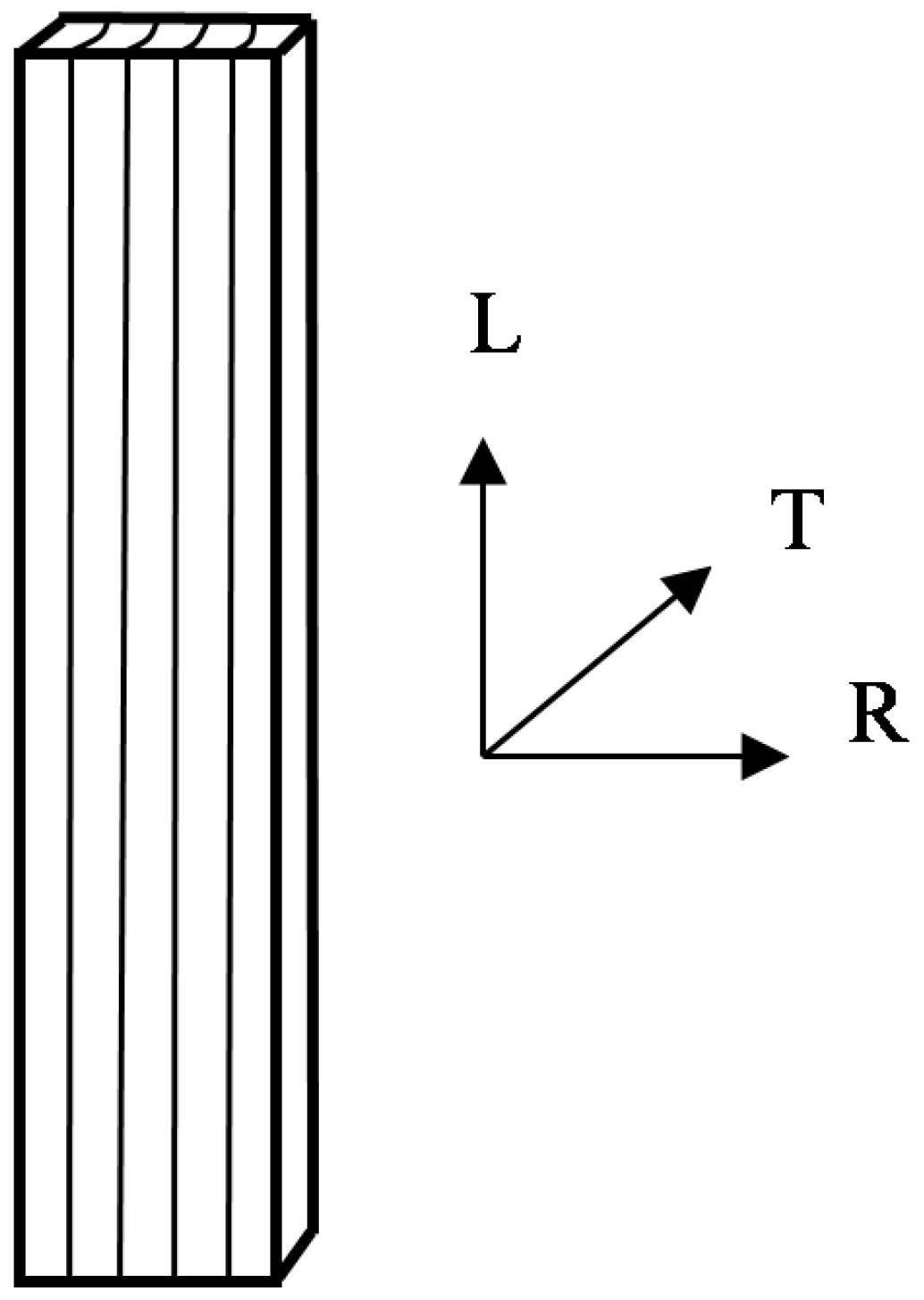
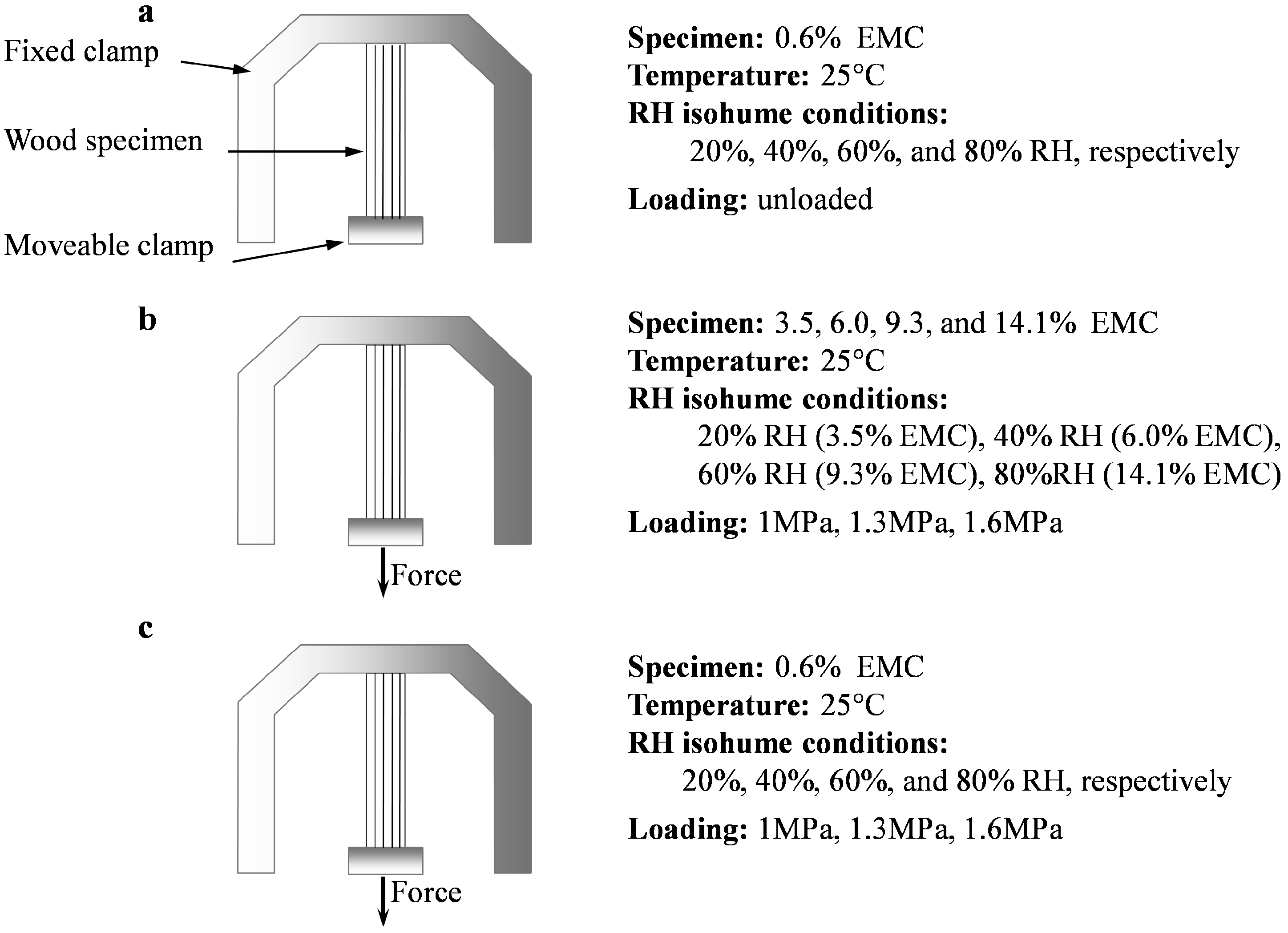
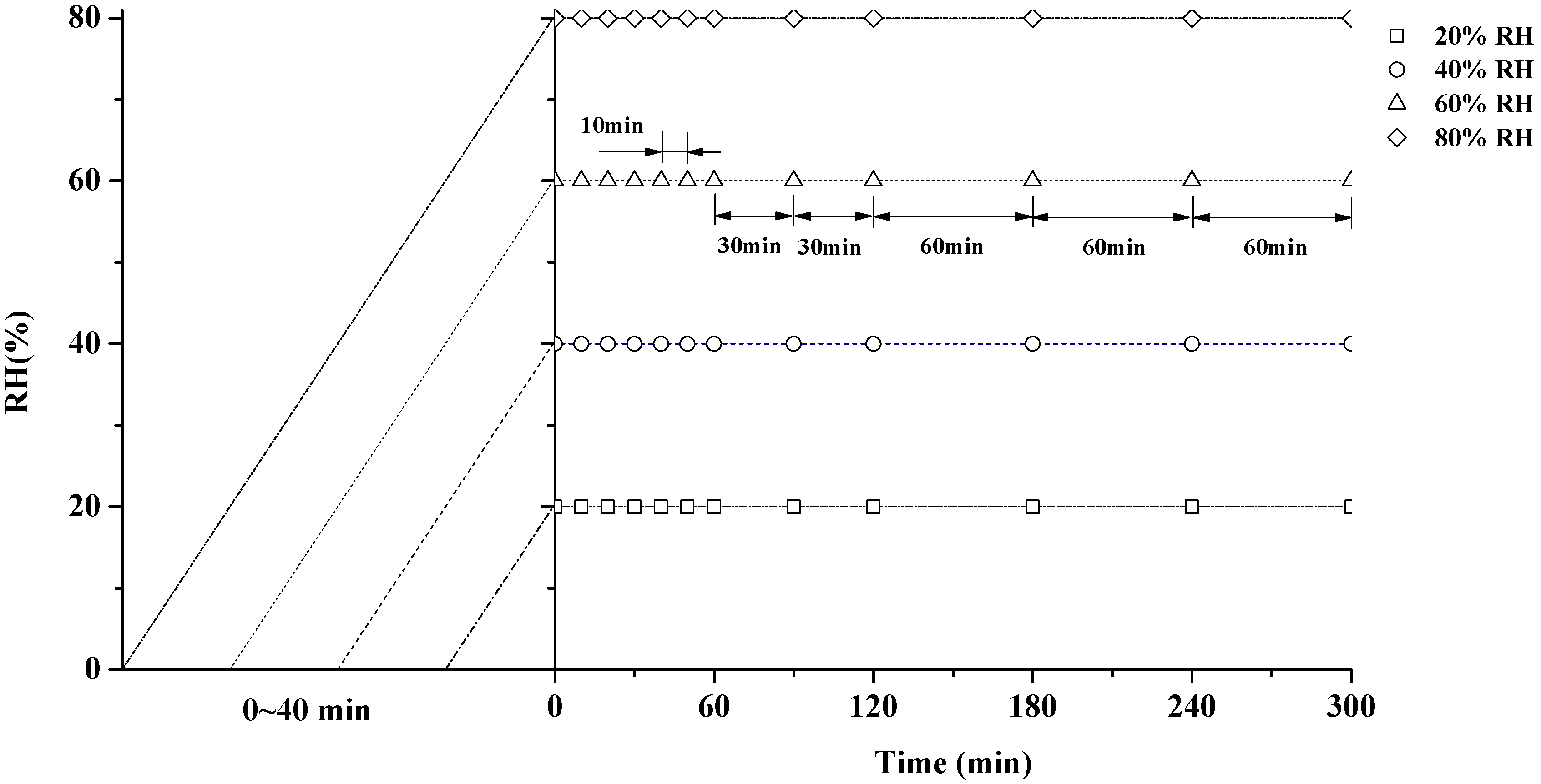
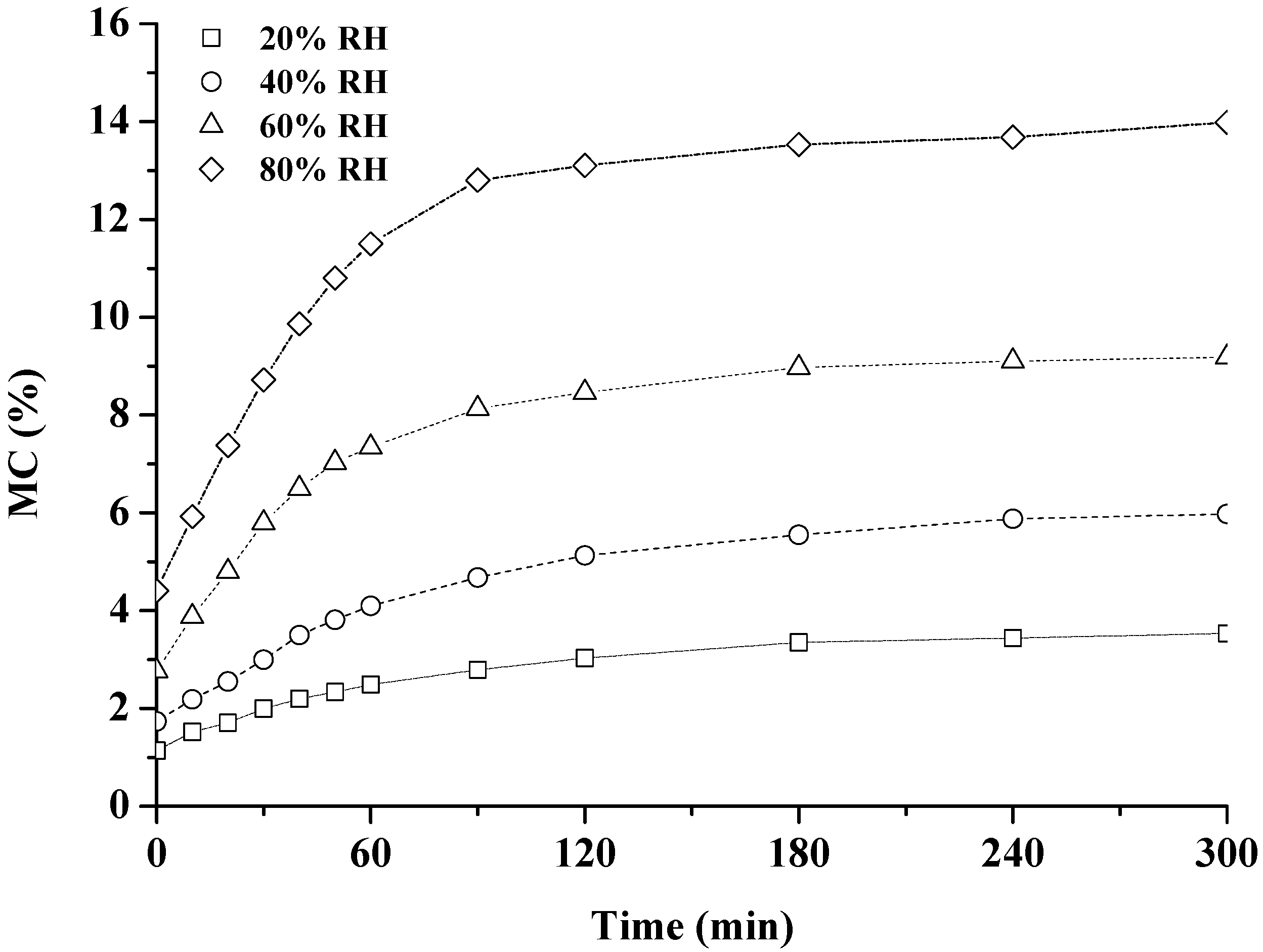
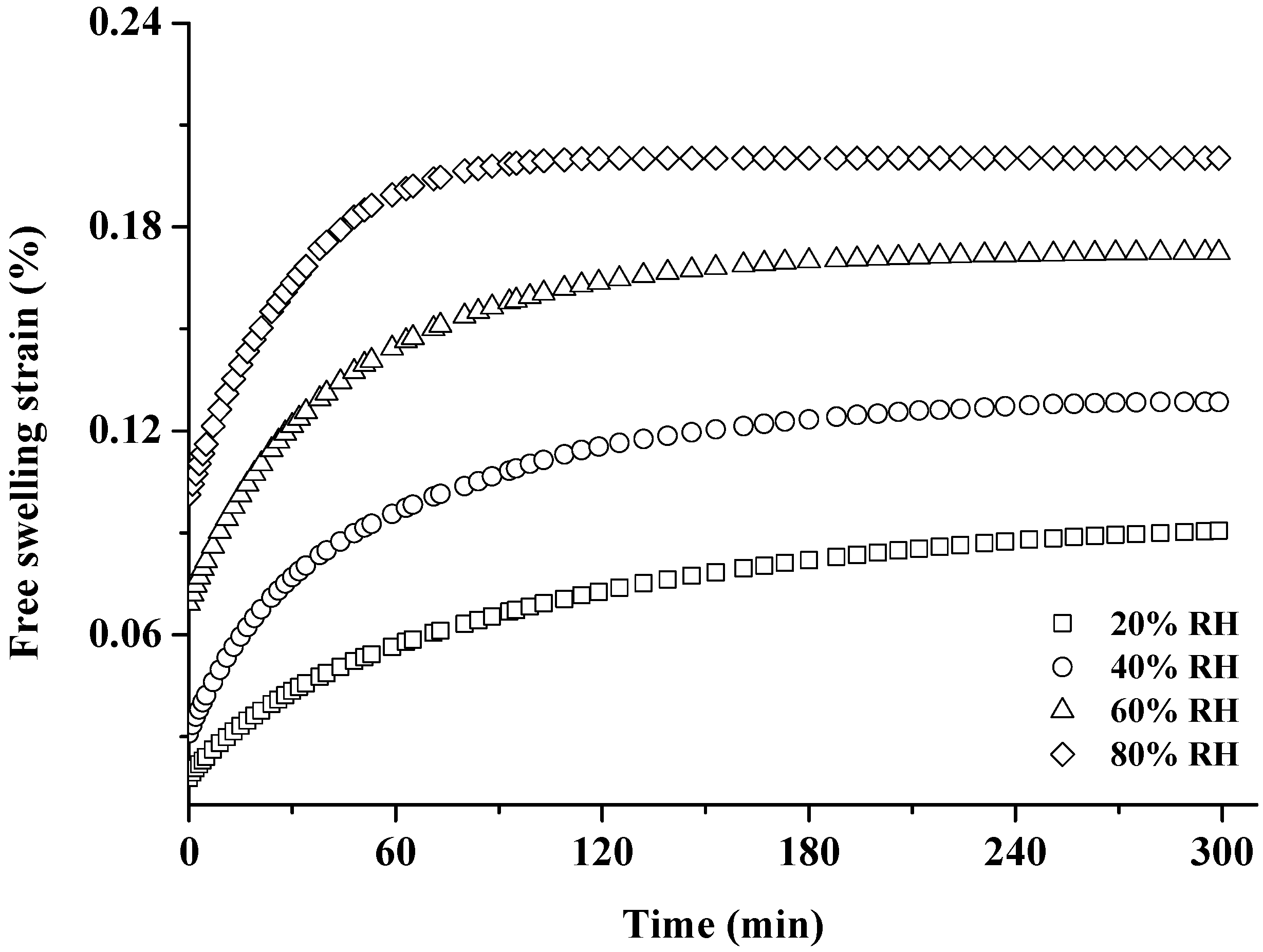
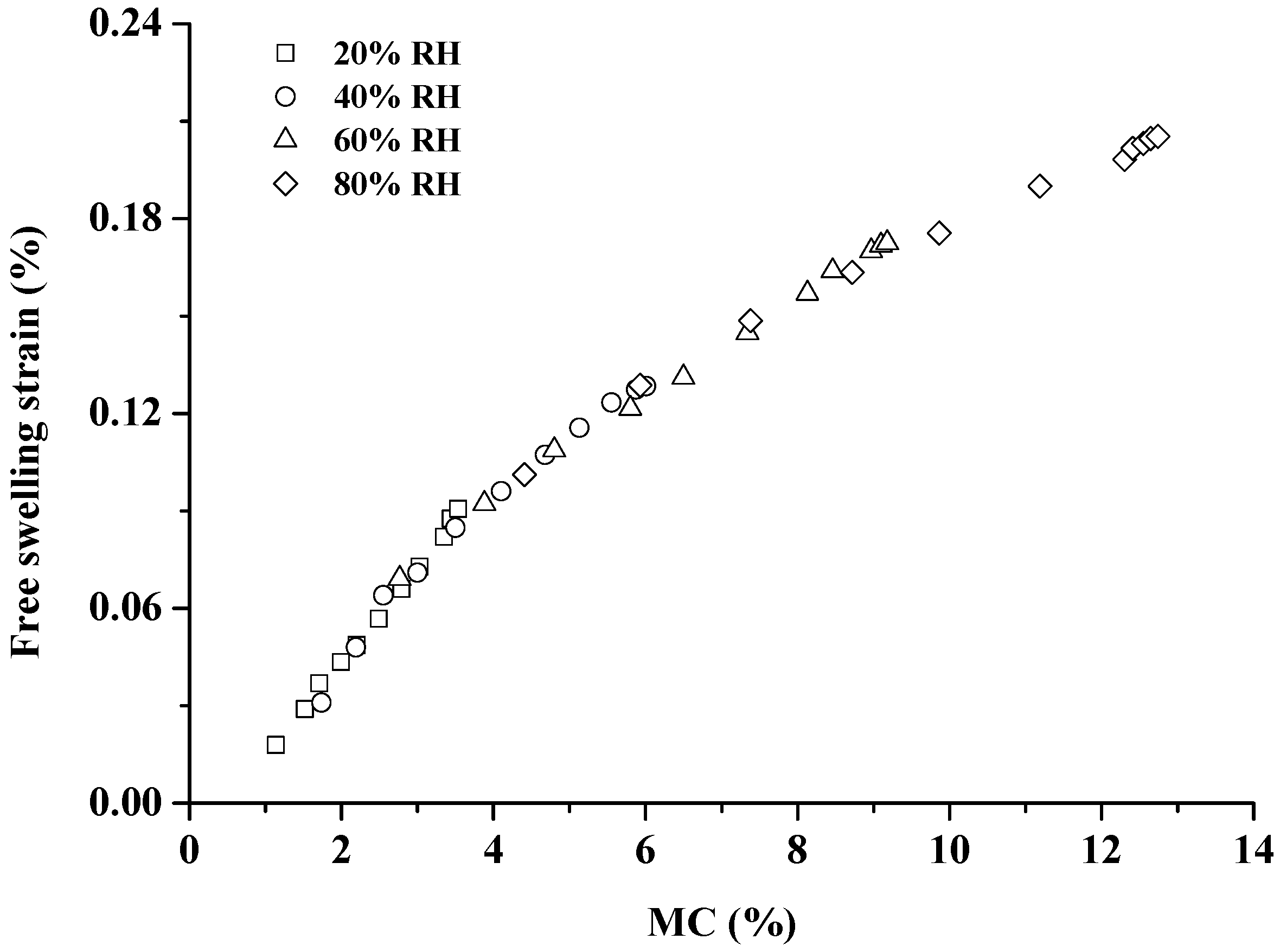
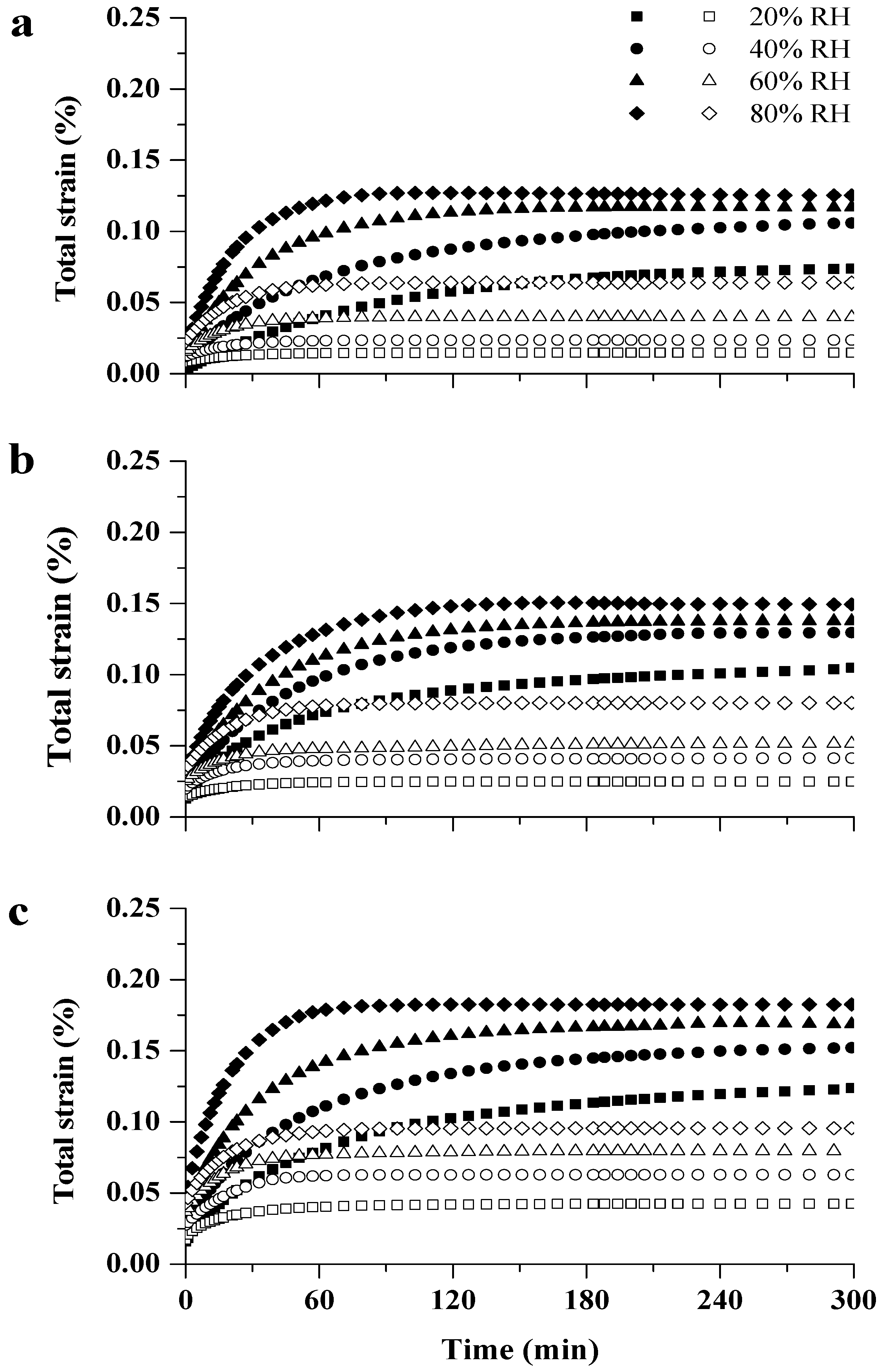
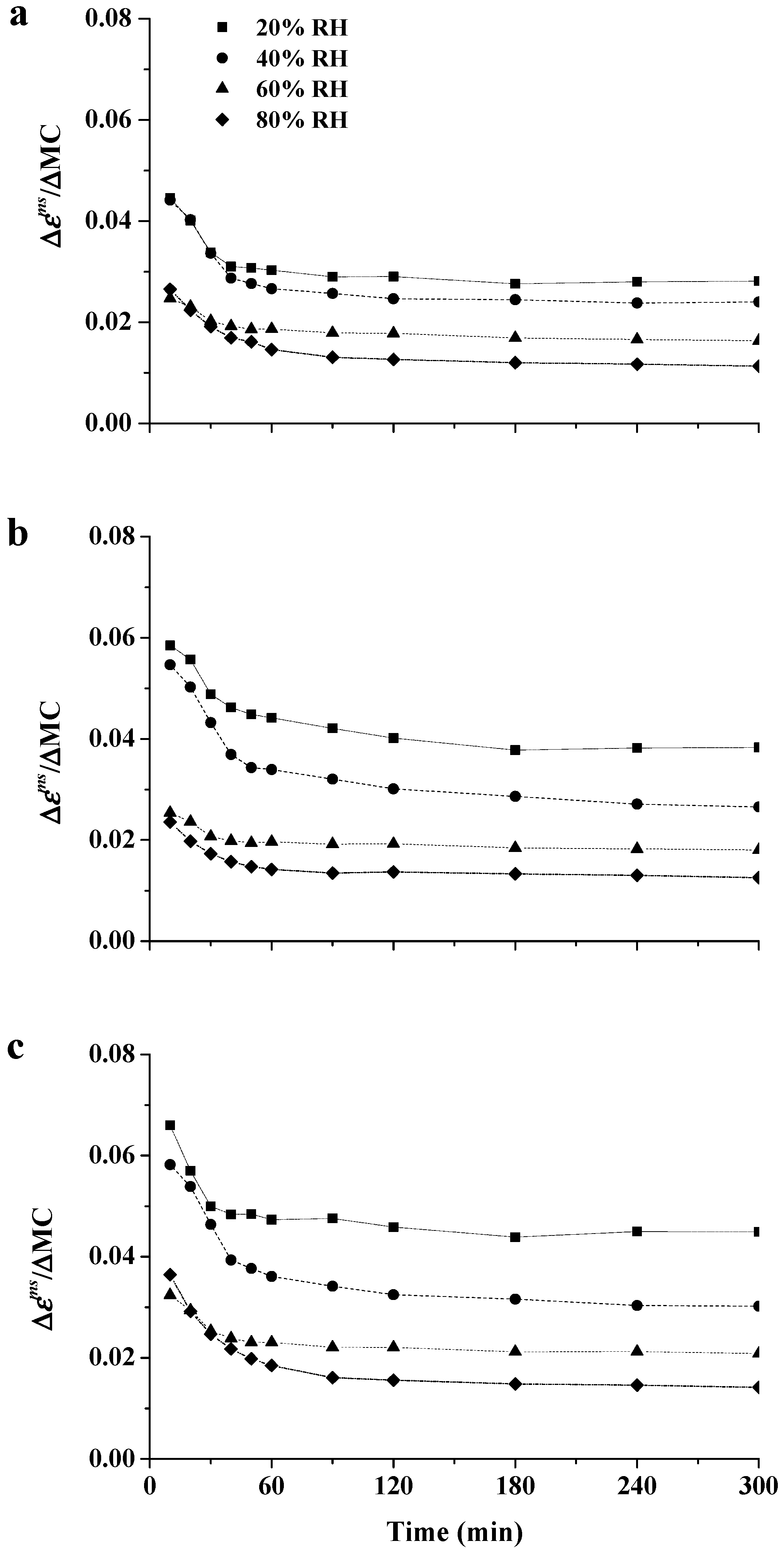
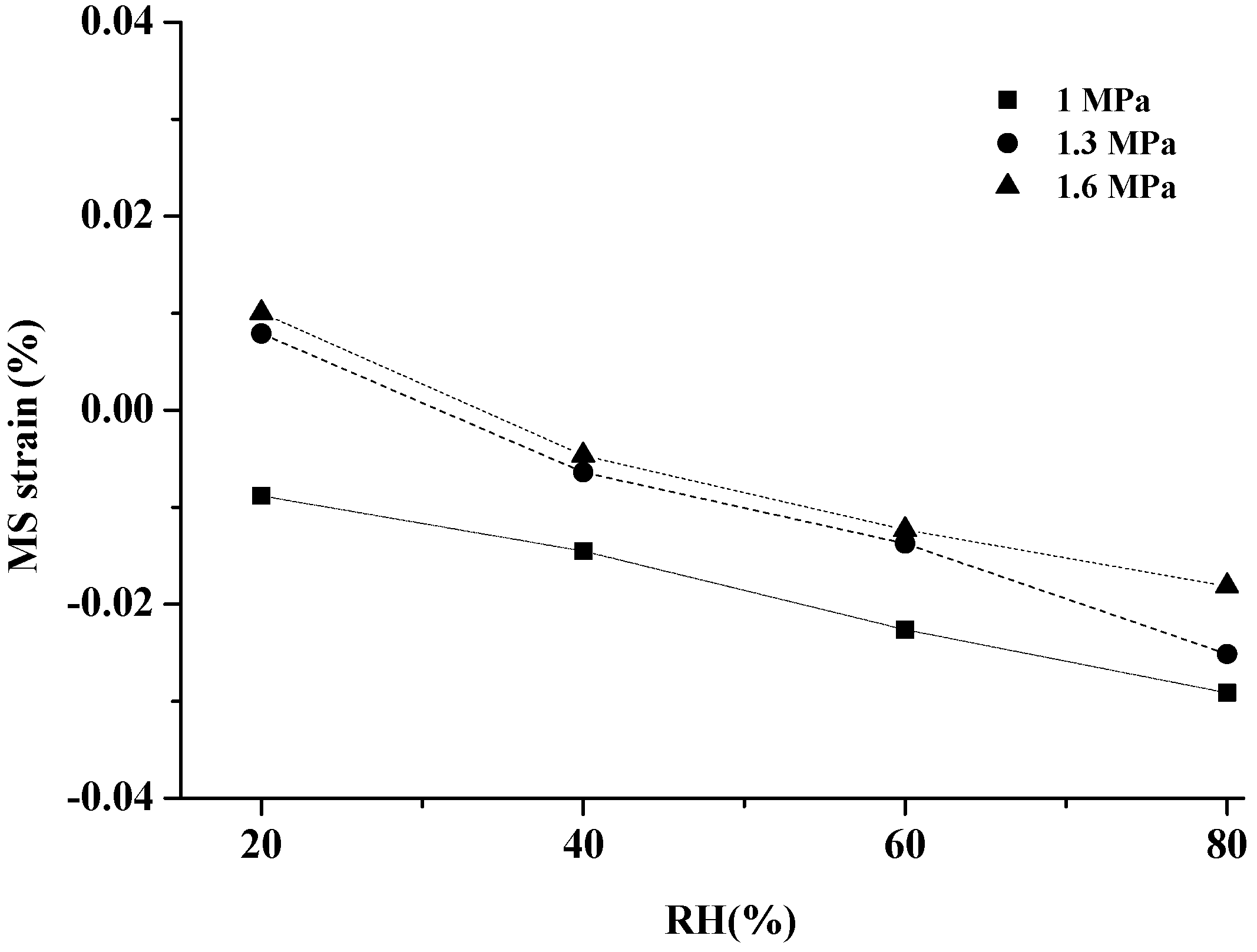
| Parameter | Stress (MPa) | VEC | MSC | ||||||
|---|---|---|---|---|---|---|---|---|---|
| 20% RH | 40% RH | 60% RH | 80% RH | 20% RH | 40% RH | 60% RH | 80% RH | ||
| MC0 | 3.5% | 6.0% | 9.3% | 14.1% | 1.1% | 1.7% | 2.8% | 4.4% | |
| εe (%) | 1 | 0.007 | 0.012 | 0.016 | 0.022 | 0.002 | 0.004 | 0.012 | 0.017 |
| 1.3 | 0.013 | 0.020 | 0.025 | 0.033 | 0.013 | 0.017 | 0.022 | 0.029 | |
| 1.6 | 0.017 | 0.028 | 0.037 | 0.042 | 0.016 | 0.024 | 0.035 | 0.041 | |
| MC300 | 3.5% | 6.0% | 9.3% | 14.1% | 3.5% | 6.0% | 9.3% | 14.1% | |
| εv(300) (%) | 1 | 0.008 | 0.012 | 0.024 | 0.042 | 0.072 | 0.102 | 0.105 | 0.108 |
| 1.3 | 0.011 | 0.021 | 0.026 | 0.047 | 0.092 | 0.113 | 0.116 | 0.120 | |
| 1.6 | 0.025 | 0.035 | 0.051 | 0.053 | 0.108 | 0.128 | 0.134 | 0.136 | |
| Stress (MPa) | RH (%) | VEC | MSC | ||||||
|---|---|---|---|---|---|---|---|---|---|
| a | b | λ | r2 | a | b | λ | r2 | ||
| 1 | 20 | 0.01 | −0.01 | 18.50 | 0.99 | 0.08 | −0.07 | 85.69 | 0.99 |
| 40 | 0.02 | −0.01 | 18.26 | 0.99 | 0.10 | −0.09 | 58.68 | 0.99 | |
| 60 | 0.04 | −0.02 | 17.51 | 0.99 | 0.12 | −0.10 | 35.41 | 0.99 | |
| 80 | 0.06 | −0.04 | 19.02 | 0.99 | 0.13 | −0.11 | 21.35 | 0.99 | |
| 1.3 | 20 | 0.02 | −0.01 | 19.32 | 0.99 | 0.10 | −0.08 | 56.45 | 0.99 |
| 40 | 0.04 | −0.02 | 18.33 | 0.99 | 0.13 | −0.11 | 48.50 | 0.99 | |
| 60 | 0.05 | −0.02 | 21.25 | 0.98 | 0.14 | −0.11 | 39.77 | 0.99 | |
| 80 | 0.08 | −0.05 | 19.60 | 0.99 | 0.15 | −0.12 | 32.42 | 0.99 | |
| 1.6 | 20 | 0.04 | −0.02 | 20.06 | 0.99 | 0.12 | −0.10 | 67.61 | 0.99 |
| 40 | 0.06 | −0.04 | 19.14 | 0.99 | 0.15 | −0.12 | 54.80 | 0.99 | |
| 60 | 0.08 | −0.04 | 17.58 | 0.99 | 0.17 | −0.13 | 37.31 | 0.99 | |
| 80 | 0.10 | −0.05 | 18.07 | 0.99 | 0.18 | −0.14 | 19.36 | 0.99 | |
© 2017 by the authors. Licensee MDPI, Basel, Switzerland. This article is an open access article distributed under the terms and conditions of the Creative Commons Attribution (CC BY) license (http://creativecommons.org/licenses/by/4.0/).
Share and Cite
Peng, H.; Lu, J.; Jiang, J.; Cao, J. Longitudinal Mechano-Sorptive Creep Behavior of Chinese Fir in Tension during Moisture Adsorption Processes. Materials 2017, 10, 931. https://doi.org/10.3390/ma10080931
Peng H, Lu J, Jiang J, Cao J. Longitudinal Mechano-Sorptive Creep Behavior of Chinese Fir in Tension during Moisture Adsorption Processes. Materials. 2017; 10(8):931. https://doi.org/10.3390/ma10080931
Chicago/Turabian StylePeng, Hui, Jianxiong Lu, Jiali Jiang, and Jinzhen Cao. 2017. "Longitudinal Mechano-Sorptive Creep Behavior of Chinese Fir in Tension during Moisture Adsorption Processes" Materials 10, no. 8: 931. https://doi.org/10.3390/ma10080931




